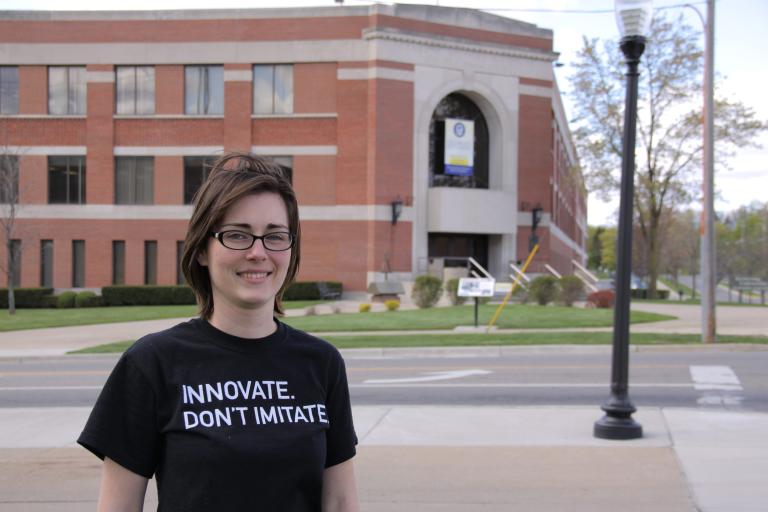
“The Innovation Center is perfect for those who are trying to have a green impact and want a place to call home.”
If New Urbanism had a face in Flint, Michigan, it would look a lot like Kristina Kamensky, the young and enthusiastic CEO of Prismitech LLC. Kamensky’s company focuses on refrigeration that weds high-tech artificial intelligence with green ideals.
Kamensky earned her bachelor’s degree in Mechanical Engineering at Kettering University in 2009 and followed it up with a master’s degree in 2012. Her ties to Kettering helped make Prismitech one of the first tenants in Kettering’s award-winning Innovation Center, a facility that provides up and coming businesses with dedicated wet and/or dry laboratory capabilities during the first few years of their development. The Innovation Center, which is in close proximity to the university’s science and engineering assets and experts, is also the first LEED certified building in Genesee County.
The Innovation Center addresses an up-until-now missing piece in the local mosaic of policies, infrastructure, financing, educational programming, and mechanisms of support for forming and nurturing science and technology-based small businesses, Kamensky said. “The Innovation Center is perfect for those who are trying to have a green impact and want a place to call home,” she said. “I also like the fact that it is located on Kettering’s campus, where companies can utilize laboratory facilities for testing purposes,” she explained. “It makes me feel like a pioneer.”
Kamensky is one of a growing number of college-aged entrepreneurs and recent college grads who are “urbaneers” (urban pioneers) in the New Urban Flint territory. In addition to housing her growing business on the campus of her alma mater, Kamensky recently bought a house within walking distance of the campus. She frequently bikes to work on her vintage-style Electra.
What is the lure of this post-industrial town that is working hard to re-invent itself? Kamensky said it’s the vision and dedication of diverse people and groups addressing a myriad of issues concurrently while creating a new urban fabric out of this old factory town.
Flint’s New Urban landscape includes the expansion of the River Trail, new businesses re-populating the downtown area, a thriving Farmer’s Market within walking distance of downtown and a dynamic small city arts and music scene that ties the diverse community together with monthly Art Walks and seasonal Art in the Parks and Music in the Parks programs.
Kettering University is embedded in many of these initiatives. When Kamensky peddles to work she travels the re-named University Avenue (formerly Third Avenue) that connects Kettering and the University of Michigan-Flint campuses. The name change, part of the College Town Initiative with Kettering, UM-Flint, Baker College and Mott Community College, was accomplished by re-surfacing the street into a boulevard with new landscaping and street lighting from the west side of Kettering’s campus all the way to UM-Flint’s White Building (approximately three miles).
University Avenue is also part of the Carriage Town Historic District revitalization, that bi-sects the neighborhood surrounding and being re-developed by Hurley Medical Center and Atwood Stadium Authority.
The College Town Initiative is a partnership that brings together the unique resources of the four campuses to address the challenges of today's economy and benefit the region. It includes several formal articulation agreements between the partners and a series of activities designed to help overcome the reluctance of students to venture beyond the boundaries of their own campuses, thereby creating an integrated academic community of young people.
This social collaboration includes events such as the College Town Blood Battle, wherein the four campuses compete to secure the most blood donations for the American Red Cross; a similar competition raises funds and donations of food for the Food Bank of Eastern Michigan; the College Town LEGO contest, College Night movies at the Flint Institute of Arts and the Battle of the Bins recycling challenge.
When she visits the Innovation Center, Kamensky is literally at a crossroads for the Flint River Trail project, a 17-mile bike/inline skate/walking/fishing asphalt trail along the banks of the Flint River, stretching from Mott Lake at its northernmost point to just south of Kettering’s campus past Mott Golf Course. Kettering worked with the Crim Fitness Foundation and the State of Michigan to develop the trail through the campus with expansions of existing sidewalks, lighting, landscaping and signage.
Other occupants of the Innovation Center are also good examples of Flint’s New Urbanism. Swedish Biogas International, a company working with the City of Flint wastewater treatment facility to process human waste and food waste into biogas as an alternative energy source, collaborates with Kettering faculty and students on research. The Swedish Biogas project is a partnership between Kettering University, the City of Flint, the state of Michigan and Swedish Biogas International, of Linkoping, Sweden.
Kettering researchers are currently working on a process to refine the biogas into bio-methane for use fueling vehicles, like the 2500HD Chevy Silverado that was converted to run on a dual-fuel system and renewable natural gas.
Kettering and Swedish Biogas are also working with the City of Flint on a Phytoremediation project to use municipal compost and biogas processing derivatives to provide organic cover for an industrial brown field within the city. The area, adjacent to the Kettering campus, will be rehabilitated as a green space along the banks of the Flint River from the east side of campus to downtown Flint.
On Fridays, Kamensky can peddle along the Flint River Trail toward downtown to attend her weekly Rotary meeting. She joined the service club to connect with other business owners and leaders in Flint, and enjoys the group’s community service focus and the opportunity to meet and work with everyone from a retired Horologist to a political aide-de-camp her own age.
Like all pioneers, Kamensky sees potential instead of problems. She and other young urbaneers are helping reshape Flint into their own version of a frontier town.